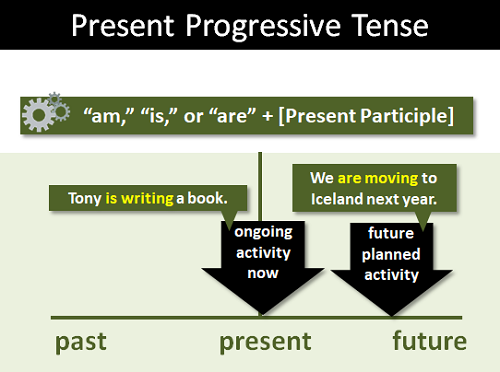PRESENT PROGRESSIVE TENSE
What Is the Present Progressive Tense? (with Examples)
The present progressive tense is used for an ongoing action in the present. For example:
- John is baking a cake.
- They are painting the fence.
Even though it is a present tense, the present progressive tense can also be used to describe an activity that is going to happen in the future (especially for planned activities). For example:
- We are moving to New Zealand in the summer.
- The train is arriving in 2 minutes.
Examples of the Present Progressive Tense
- Caroline is looking for the latest brochure.
- Dan and Billy are fishing off the pier.
- A lot of good arguments are spoiled by some fool who knows what he is talking about. (Playwright Miguel de Unamuno)
- Middle age is when you are sitting at home on a Saturday night and the telephone rings and you hope it isn't for you. (Poet Ogden Nas)
Forming the Present Progressive Tense
The present progressive tense is formed like this:
"am," "is," or "are"
+ [present participle ("verb-ing")]
Choose "am," "is," or "are" based on the following table:
| Subject | Verb "to be" | Present Participle |
|---|---|---|
| I | am | [verb] + "ing" |
| You | are | |
| He / She / It (or singular noun) | is | |
| We | are | |
| You | are | |
| They (or plural noun) | are |
For example:
- She is running.
- I am talking.
Forming the Present Participle
Add "ing" to most verbs:
- play > playing
- shout > shouting
For verbs that end "e", remove the "e" and add "ing":
- prepare > preparing
- ride > riding
For verbs that end "ie", change the "ie" to "y" and add "ing":
- lie > lying
- untie > untying
For verbs whose last syllable is written [consonant-vowel-consonant] and is stressed, double the final consonant and add "ing":
- run > running
- forget > forgetting
The Negative Version
If you need the negative version, you can use the following construction:
"am," "is," or "are"
+ "not"
+ [present participle]
- Caroline is not looking for the latest brochure.
- Dan and Billy are not fishing off the pier.
Remember that "is not" and "are not" are sometimes written as the contractions "isn't" and "aren't."
The Question Version
If you need to ask a question, you can use the following word order for a yes/no question:
"am," "is," or "are"
+ [subject]
+ [present participle]
- Is Caroline looking for the latest brochure?
- Are Dan and Billy fishing off the pier?
[question word]
+ "am," "is," or "are"
+ [subject]
+ [present participle]
- Why is Caroline looking for the latest brochure?
- When are Dan and Billy fishing off the pier?
You can use the following word order for a choice question:
"am," "is," or "are"
+ [subject]
+ [present participle]
+ choice A
+ or
+ choice B
- Is Caroline looking for the latest brochure or her chair?
"am," "is," or "are"
+ [subject]
+ present participle A
+ or
+ present participle B
- Are Dan and Billy fishing off or jumping off the pier?
Infographic for the Present Progressive Tense

Comentarios
Publicar un comentario